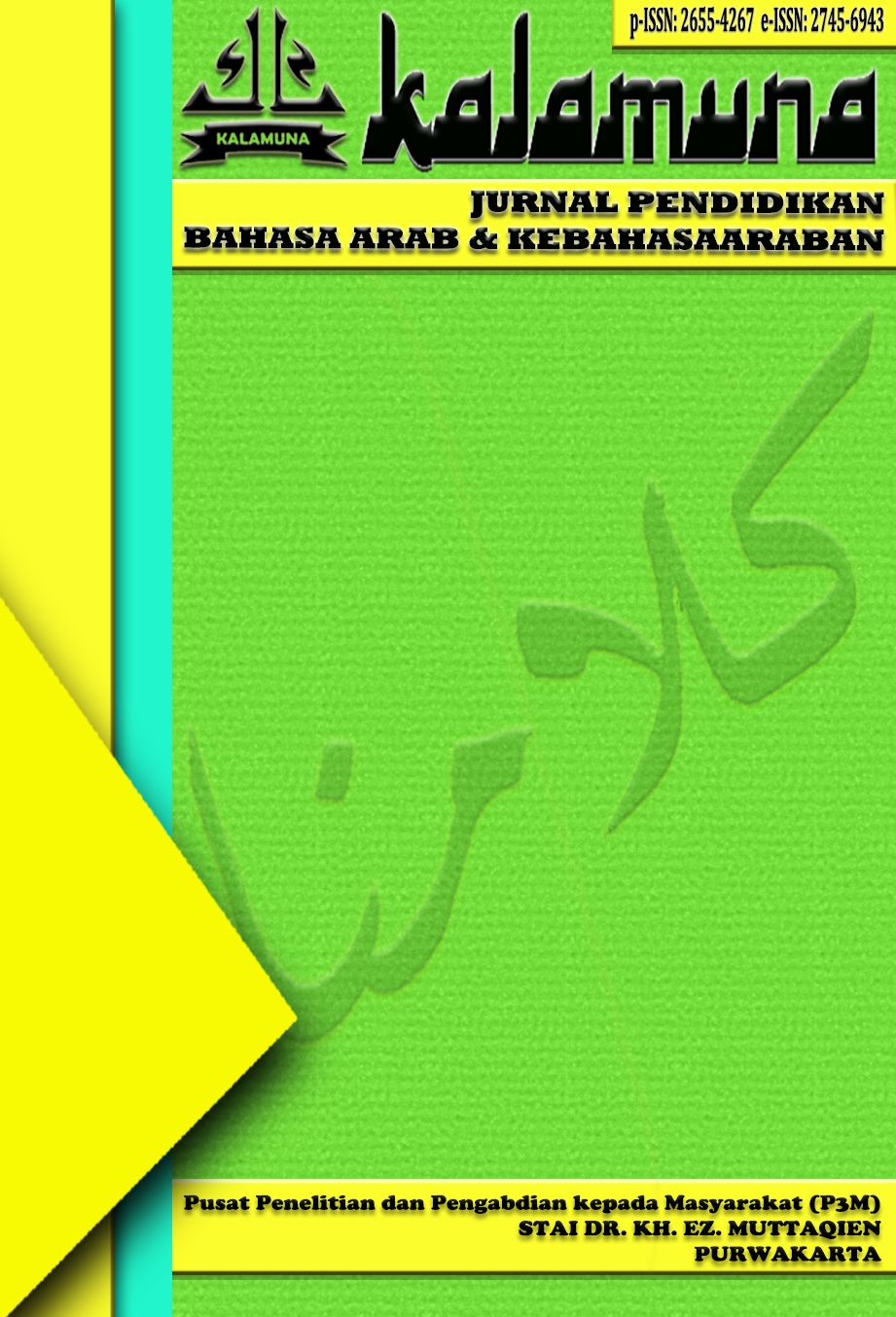The Effect of Artificial Intelligence (AI) on Willingness to Communicate in Arabic Language Learning
Keywords:
Artificial Intelligence, Willingness to Communicate, Arabic language learningAbstract
The low Willingness to Communicate (WTC) in Arabic language learning has become a barrier to mastering communicative competence, often caused by students' low self-confidence. This study aims to analyze the impact of AI usage on students' WTC in Arabic language learning. A quantitative approach was employed, and data were collected using a Likert-scale questionnaire measuring WTC, self-confidence, and motivation. The sample consisted of students from Arabic Education programs at several universities, selected using cluster random sampling techniques. The findings reveal that AI has a significant positive effect on WTC by creating a supportive, interactive, and adaptive learning environment. AI provides personalized feedback that helps boost students' confidence. AI-based technology plays a crucial role in enhancing WTC and supporting the success of Arabic language learning. This study lays the foundation for developing technology-based pedagogical strategies and emphasizes the importance of improving WTC for successful Arabic language acquisition.
References
Alfi, A. M., Febriasari, A., & Azka, J. N. (2023). Transformasi pendidikan agama islam melalui teknologi. Religion: Jurnal Agama, Sosial, Dan Budaya, 2(4), 511–522.
Azhar, M., Wahyudi, H., Promadi, P., & Masrun, M. (2023). Penggunaan Teknologi Dalam Pembelajaran Bahasa Arab Di Indonesia. Jurnal Review Pendidikan Dan Pengajaran (JRPP), 6(4), 3160–3168.
Belda-Medina, J., & Kokošková, V. (2023). Integrating chatbots in education: Insights from the Chatbot-Human Interaction Satisfaction Model (CHISM). International Journal of Educational Technology in Higher Education, 20(1), 62. https://doi.org/10.1186/s41239-023-00432-3
Fathi, J., Rahimi, M., & Derakhshan, A. (2024). Improving EFL learners’ speaking skills and willingness to communicate via artificial intelligence-mediated interactions. System, 121, 103254.
Febriani, R., Sya, M. F., & Mulyanti, E. (2024). Memahami Metode Terjemahan Tata Bahasa: Potensi dan Tantangan dalam Konteks Pendidikan Bahasa Modern. Karimah Tauhid, 3(5), 5721–5728.
Ghafar, Z. N., Salh, H. F., Abdulrahim, M. A., Farxha, S. S., Arf, S. F., & Rahim, R. I. (2023). The role of artificial intelligence technology on English language learning: A literature review. Canadian Journal of Language and Literature Studies, 3(2), 17–31.
Hamid, T. A., Kosim, A., & Azhar, M. (2024). Problematika Pemerolehan Bahasa Arab pada Santri berkepribadian Ekstrovert dan Introvert. Kalamuna: Jurnal Pendidikan Bahasa Arab dan Kebahasaaraban, 5(2), Article 2. https://doi.org/10.52593/klm.05.2.12
Jiang, R. (2022). How does artificial intelligence empower EFL teaching and learning nowadays? A review on artificial intelligence in the EFL context. Frontiers in Psychology, 13, 1049401.
Kaur, P., Stoltzfus, J., & Yellapu, V. (2018). Descriptive statistics. International Journal of Academic Medicine, 4(1), 60–63.
Lee, J. S., & Drajati, N. A. (2019). Affective variables and informal digital learning of English: Keys to willingness to communicate in a second language. Australasian Journal of Educational Technology, 35(5), 168–182.
Macintyre, P., Clément, R., & Donovan, L. (2002). Willingness to Communicate in the L2 Among French Immersion Students.
Macintyre, P. D., Clément, R., Dörnyei, Z., & Noels, K. A. (1998). Conceptualizing Willingness to Communicate in a L2: A Situational Model of L2 Confidence and Affiliation. The Modern Language Journal, 82(4), 545–562. https://doi.org/10.1111/j.1540-4781.1998.tb05543.x
Makarim, B. (2024). Pengaruh Motivasi Belajar Bahasa Inggris, Kepercayaan Diri, dan Faktor Demografi terhadap Willingness to Communicate in English Language Siswa di Pondok Pesantren Al-Ittihad Cianjur [B.S. thesis, Fakultas Psikologi UIN Syarif Hidayatullah Jakarta]. https://repository.uinjkt.ac.id/dspace/handle/123456789/79527
Malayu, O. A. N., & Ritonga, A. (2024). Peran Teknologi Artificial Inttelligence (AI) Dalam Pembelajaran Pendidikan Agama Islam. Mauriduna: Journal of Islamic Studies, 5(2), 141–150.
Maryam, N. K. (2020). Penggunaan metode safinda dalam pembelajaran bahasa arab di madrasah aliyah muro’atuddin magetan (penelitian eksperimen di madrasah aliyah muro’atuddin magetan tahun ajaran 2019/2020) [PhD Thesis, IAIN Ponorogo]. https://etheses.iainponorogo.ac.id/id/eprint/12757
Mukarom, A. M. (2024). Eksplorasi Faktor Individu Peserta Didik dalam Pembelajaran Bahasa Kedua: Analisis Isi Buku Rod Ellis. Borneo Journal of Islamic Education, 4(1), Article 1. https://doi.org/10.21093/bjie.v4i1.9114
Nafi’ah, H., & Setiyawan, A. (2024). Psycholinguistics in 21st Century Arabic Language Learning. Kalamuna: Jurnal Pendidikan Bahasa Arab dan Kebahasaaraban, 5(1), Article 1. https://doi.org/10.52593/klm.05.1.08
Sugeng, B. (2022). Fundamental metodologi penelitian kuantitatif (eksplanatif). Deepublish. https://scholar.google.com/scholar?cluster=15836376426182916913&hl=en&oi=scholarr
Vygotsky, L. S. (1978). Mind in society: The development of higher psychological processes (Vol. 86). Harvard university press. https://books.google.com/books?hl=id&lr=&id=RxjjUefze_oC&oi=fnd&pg=PA1&dq=Mind+in+society:+The+development+of+higher+psychological+processes.+&ots=okyXT4l1cx&sig=Q5JVEVyImUD51nT1BHiNuM1dPNk
Wang, J., & Wang, S. (2019). Preparation, modification and environmental application of biochar: A review. Journal of Cleaner Production, 227, 1002–1022.
Zakiah, N. (2021). Problematika Pembelajaran Bahasa Arab Siswa Madrasah Tsanawiyah Al Islamiyah Kotabumi Lampung Utara. Indonesian Journal of Instructional Technology, 52–66.













